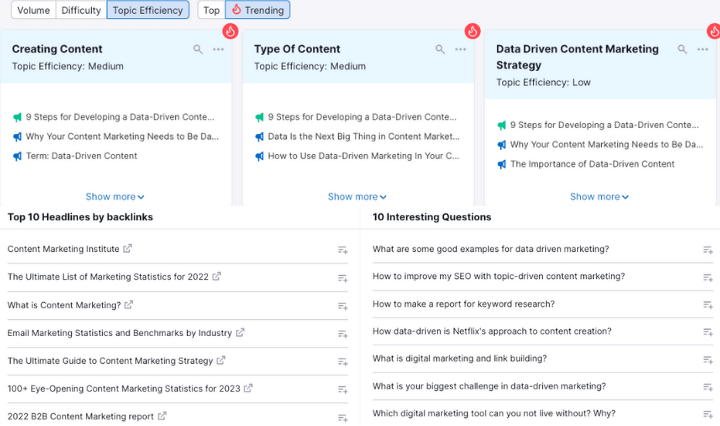Data drives the engine of successful content marketing. It is the fuel that propels our strategies forward, ensuring that our efforts are focused, targeted, and effective. However, for many businesses, harnessing the power of data in their marketing endeavors remains a challenge.
Surprisingly, a recent study revealed that a staggering 56% of businesses only consider “data-driven” as a mere slogan, while an overwhelming 87% of marketers believe that their organization’s most underutilized asset is data. These statistics highlight the urgent need for us to delve deeper into the world of data-driven content marketing and explore ways to leverage it more effectively. So, how do we bridge the gap between understanding the importance of data and actually implementing it in our content marketing strategies? Let’s dive into three key phases that can help us develop a robust data-driven content marketing approach.
What is Data-Driven Content Marketing
Data-driven content marketing is a strategic approach to content that is created based on market research using a variety of data touch points such as website analytics, social media insights, SEO research tools, and other data collecting methods to define a company’s content strategy that blends a mix of content to use for blog content, social media activations, email marketing, paid media advertising, video content, podcast topics, and more. Data-driven content marketing creates seamless brand messaging continuity through an omnichannel marketing approach that is constantly optimized for performance.
Steps to Developing a Data-Driven Content Marketing Strategy
1. Gathering Data
Key Metrics
- Website Traffic Statistics – Understanding the data in your analytics reports is crucial to running effective digital marketing campaigns. Google Analytics collects web traffic and audience information to inform you who your site visitors are, acquisition data to tell you how users got to your site whether it was through a marketing campaign, a social channel, or by email or other traffic sources. Check out your top organic landing pages to find out how Google is correlating your brand with your top content. Use this as a jumping off point to explore other related topics so you can expand on what content is currently performing.
- Social Media Engagement (Shares, Likes, Comments) – Using social listening tools is important to surface what people are saying about brands, products, customer service, customer experience, related industry topics, and industry pain points. Having a good social listening strategy encompasses taking that insight and applying it to your marketing campaigns.
- Trending Topics – Using SEO tools like SEMRush you can explore trending topics and frequently asked questions that are surrounding your products or services as well as your brand term. Use this information to guide an FAQ page so you can own those search queries. Another way to use this information is to answer FAQs in your ad copy. Legrage these insights to expand on your blog coverage or develop thought leadership topics for the C-suite.
Tools for Data Collection
- Google Analytics – Although GA is the most commonly used marketing analytics solution, there are other service platforms and analytics tools such as Adobe Analytics, Matomo and Coremetrics. No matter which service you use, they all track and gather website performance and user behavior to help identify opportunities and insights to make directional business decisions.
- Social Media Listening – Social listening tools monitor conversations across multiple social media platforms such as Facebook, TikTok, YouTube, and X, using social listening tools to gain valuable insights on brand reputation. Having a good social listening strategy encompasses taking that insight and applying it to your marketing campaigns. If you listen long enough, that social data gives your team actionable insights on how to deliver a social media marketing strategy that could help an organization differentiate from competitors, to improve brand reputation, or to produce content that is timely and topical.
- SEO Tools – SEMRush is a great tool for market research as there is access to multiple touch points such as competitor keyword gap analysis, emerging competitors, backlink analysis, content topic research tools, keyword research, SERP analysis, keyword difficulty scores, and more. Another great SEO tool to use for domain authority analysis research is Moz. Using these tools combined will give you plenty of insight to start planning your SEO focused content strategy.
2. Steps to Developing a Data Driven Content Strategy
- Define Marketing KPIs– Before getting started (or at least do this the same time you’re collecting marketing research) you’ll want to define your measurement framework. A measurement framework is an outline around how the success of something will be measured and what is needed to properly track success factors. Setting up strategic goals and aligning them with your KPIs are essential to building a measurement framework. In order to identify which KPIs you will need to measure the success factors of your campaign, you will need to know what the specific goal is that you are working towards. Identify if you’re trying to increase brand awareness, increase conversion rates, increasing leads or revenue. Next recrd your benchmarks to measure your campaigns against to determine success or areas of opportunity.
- Define Your Audience – Defining your audience personas are really just a start, and a variety of other tools exist to help content marketers pinpoint the information that most interests their audience and generate content ideas to match. This understanding informs everything from the choice of blog topics, to voice and tone, to the distribution methods and social engagement strategies we employ. By narrowing our focus, we can ensure that the people visiting our blogs or engaging with our social channels genuinely care about the topics we discuss. To define our target audience, we can start by analyzing our existing customer data. This provides us with a strong starting point and invaluable insights into the demographics, industry, business size, and job titles of our customers. For B2B companies, it is crucial to prioritize data points such as industry, business size, and job title over characteristics like age, gender, or income. These insights are invaluable in creating accurate buyer personas, ensuring that every part of our content strategy addresses the pain points and interests of our target audience.
- Leverage SEO Insights – To get started you’ll want to run a competitor keyword gap analysis where you identify competiotr keyword rankings that you’re not yet targeting. Next you’ll want to take a look at your competitors top linked to content. Once you’ve compiled your initial research, you’ll want to research trending topics, keyword search volumes, and keyword difficulty scores to inform your content calendar.
- Full Funnel Strategy – Run a content audit of your site and find the holes in your customer journey and marketing funnel. Plan for content to fill this marketing funnel whether it’s a new web page like a product specific FAQ page or a informational blog post. Integrate your marketing strategy by incorporating your SEO content topics into social media activations to boost your brand awareness and overall rankings.

3. Executing on The Content Strategy
- Content Planning – By harnessing all the data and analytics you’ve collected, you can make informed decisions about the type of content to create, the topics that resonate with your target audience, and the most effective channels for distribution. It’s important to understand what content is contextually appropriate for each channel. After all, one size does not fit all, and this is especially true when it comes to content. Achieving lasting business value from content marketing is next to impossible without an effective content strategy in place. Develp a content type matrix where you define the audience and messaging per channel.
- Content Creation – Now that you’ve got your persona’s defined, pain points discovered, and trending topics nailed down and they are all in your content planning matrix, the fun begins. You’ll want to start with an outline for your blog and conduct in-depth research with examples to back up your information. You’ll want to add images, infographics, and videos to improve engagement.
5. Measuring Content Performance
Understanding how your campaigns are performing against your benchmarks can lead to directional indicators of where optimizations need to be made to improve your campaign’s key performance. Benchmarks can be related to the platform where the campaign is running, the type of ad that is being run, industry benchmarks or even your own internal benchmarks.
Putting all of this together from start to finish seems like a lot of work, but trust us it’s worth it. your marketing channels will start to naturally come together and your audience will experience a seamless experience of your brand through all your marketing channels.



